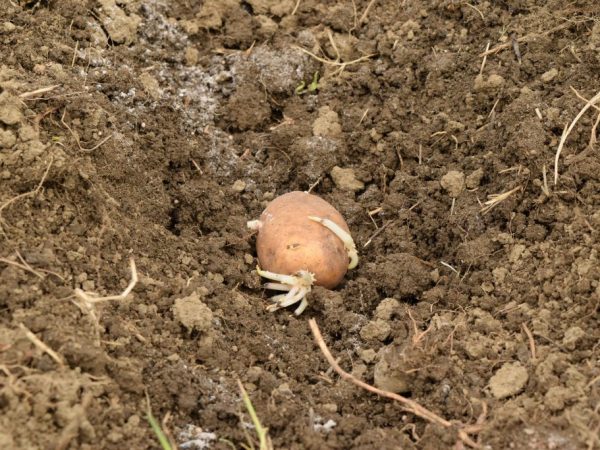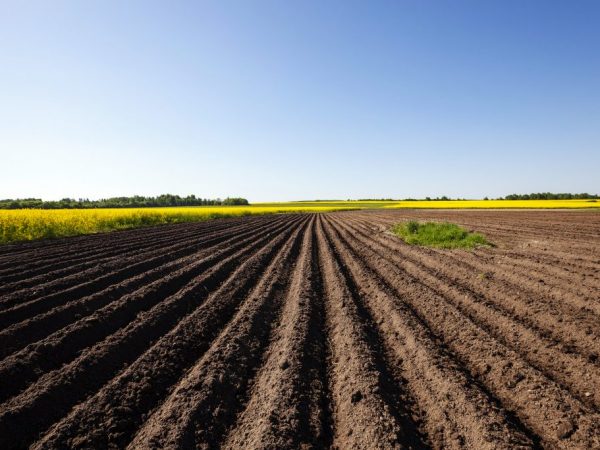Potato cultivation technology and its features
If you plan to grow potatoes, you should definitely study all the intricacies of this matter, including the technology of potato cultivation. It is worth saying that, despite the unpretentiousness of the culture, potatoes need a special soil that will loosen easily, air should get into it without hindrance, only if this condition for growing potatoes is met, it will be possible to harvest the maximum yield. Let's describe the technology of potato cultivation in the form of a technological scheme, dwelling in detail on the content of each stage.
- Stages of growing potatoes
- Land cultivation
- Preparing tubers for planting
- Dates for planting potatoes
- Planting potatoes
- Ridge or trench
- Shovel landing
- Other technologies
- Fertilization technology
- Fertilization table when planting potatoes
- Nitrogen fertilizers
- Fertilizers based on phosphorus and potassium
- Culture care
- Harvesting potatoes

Potato cultivation technology and its features
Stages of growing potatoes
Land cultivation
In order to prepare the land for planting potatoes, it is worthwhile to carry out a number of intensive measures. Speaking about the main preparatory work, it is worth saying that a lot will depend on the previous content and on what grew in the soil before, what the weather was and is the day before, whether there are weeds, and so on.
After these factors have been found, you need to start peeling the stubble of grain crops, to destroy it, the harvesting machine is immersed to a depth of not more than 7 cm.If you find perennial cereals on the site, then the land must first be thoroughly loosened, that is, make the furrows larger depth, after which the field is treated with a special herbicide solution at the rate of about 7 liters per hectare.
The plow is worked out with skimmers, while the processing depth increases to 25-30 centimeters. If, after tillage, weeds still continue to appear, then the potatoes are cultivated again, the tool is launched into the soil by 10-12 centimeters.
Regardless of the type of weed, it is customary to cultivate the soil when all types of weeds have already grown, only in this way your work will not be in vain. It is important to create a soil that will be loosened and moistened as deeply as possible.
Preparing tubers for planting
The preparatory process includes the following stages:
- Transportation and maintenance of tubers from storage or their purchase
- Getting rid of spoiled tubers
- Classification of tubers into groups and varieties
- Bringing to normal temperature, i.e. heating
- Special treatment of tubers with stimulating solution
- Sprouting sprouts in the light and so on.
For planting, it is worth using only the highest quality tubers, since the quality of the future harvest will depend on this. Currently, there is a catalog that lists all varieties of potatoes cultivated in Russia by region, for the cultivation of any of them it is extremely important to properly prepare the tubers.
Dates for planting potatoes
To harvest a good crop of potatoes, you need to choose the right crop planting dates.The earliest dates are indicated by heating the soil to a temperature of 5-8 degrees, measurements are taken at a depth of 10 cm. You can also focus on natural phenomena, such as the flowering of bird cherry bushes. If the planting data are averaged, then usually the crop is planted in late April or early May.
If it is more convenient for you to plant potatoes in April, then the depth of the tubers should be about 5 centimeters, if it is May, then the depth of the tubers increases to 10 centimeters.
Planting potatoes
Consider all methods of planting a culture.
Ridge or trench
The most optimal and intensive potato cultivation technology is the ridge technology of potato cultivation. It assumes that with the help of a hiller, rows are created, located strictly parallel to each other in areas, at an equal distance, it is often used in Russia. At the same time, grooves are formed in such ridges, into which pre-prepared potato tubers are placed. It should be said that such a planting technological scheme guarantees the maximum possible aeration of the earth, as well as the ability of the sun's rays to penetrate deeper.
Shovel landing

Tubers need to be prepared for planting
With the help of a shovel, digs are made with a depth of no more than 10 cm, after which a tuber is placed in the hole. It is worth saying that the tubers must be preheated, this happens for 14 days. After that, the hole is filled with fertilizer, then the earth is poured.
After planting, the area with potatoes must be leveled with a rake in order to retain the maximum amount of moisture in the ground. However, it is important to mention the disadvantages - such a planting scheme does not give the opportunity to give full opportunity to properly care for the crop, besides this, harvesting will also be difficult. Despite the shortcomings and peculiarities, the method enjoys unprecedented success in Russia.
Other technologies
- Dutch modern technology, the brief essence of the method is as follows - the tubers must be planted in the made ridges, however, the distance should be somewhat greater than in the first described method. The downside is that this potato cultivation technology is suitable only for those farms where agricultural machines are available, that is, a cultivator machine or a walk-behind tractor with a plow. Suitable for all types of crops.
- Meatlider's method. The peculiarity of this method is that potatoes are planted in an area with a slope, which allows you to completely abandon the hilling of the crop. To create such conditions, it is necessary to equip special oblong boxes in which the earth will be located. Suitable for all types of crops.
- Zavorovskaya landing. The last method is that a multi-tiered bush is formed, into which soil is repeatedly poured. However, in this case, human labor is required, and it is also convenient to use this technology only in small areas where mechanization is absent, it cannot be called modern. Suitable for all varieties of crops, with the exception of those that require deeper planting, it will not be easy to provide them without mechanization.
Fertilization technology
In order for the crop to come out as rich as possible, it is necessary not only to prepare the land, but also to carry out measures for harvesting and fertilizing the site in time, this is an integral part of the cultivation of potatoes. Usually, in this matter, they use a familiar map, working according to the generally accepted table, which will be given below. With this option of fertilization, about 5-6 kilograms of nitrogen, 1-2 kilograms of phosphorus, about 5 kilograms of potassium and so much calcium are usually consumed per ton of the harvested crop, the presence of magnesium in the fertilizer is also strictly required. How quickly the solution will be absorbed will depend on the rate of growth of the haulm and its development. If you managed to plant powerful tops, then the fertilizer consumption for the soil will increase by about 20-40%.
Do not forget about the simplest and most affordable way to fertilize the soil for agricultural work - about manure.
The fact is that the composition of manure contains carbon dioxide, as well as other nutrients useful for culture. A feature of the introduction of manure is that it is brought into the ground strictly in the fall, at the time when autumn plowing is carried out. If you plan to apply fresh manure to the soil, then the dates are slightly shifted, it should be applied in August. Otherwise, the risk of tuber disease with potato scab increases.
In addition to these methods, you can use the most common straw or green manure. If, when fertilizing with manure, its consumption is calculated about 35 tons per hectare, then straw and green manure are consumed more economically, about 25 tons per 1 hectare.
Fertilization table when planting potatoes
The table of fertilizing the soil when planting potatoes is as follows:
| Soil type | The amount of manure, depending on conditions | Sodium, kg / weave | Phosphorus oxide, kg / weave | Potassium oxide, kg / weave |
| Loamy earth | 50 tons, subject to introduction under the previous crop | 50 to 100 | 50 to 100 | from 50 to 100 |
| Suspended | 60 tons | 80 to 120 | 100 to 120 | 130 to 170 |
| Forest | 40 to 45 tons | 50 to 90 | 50 to 100 | 130 to 150 |
| Chernozem | From 30 to 50 tons for potatoes | 50 to 90 | From 90 to 150 | 130 to 150 |
After bringing the table, we will analyze in more detail the action of each of the components.
Nitrogen fertilizers

Nitrogen fertilizers must be applied before planting.
This type of fertilizer is applied to the soil once, right before planting potatoes, using a machine or manually. If you do this in two or more steps, it is likely that this will not affect the volume of the harvested crop in any way, that is, it will not increase. The only exception applies when potatoes are planted in areas with high humidity, where there is a lot of rainfall.
Then nitrogen fertilizers are applied twice, the first - at the stage of planting (about 60%), the second - at the stage of tuber development (the remaining 40%). However, it is important to understand that such a technological scheme can adversely affect the rate of ripening of tubers, and also, most likely, reduce the percentage of starch content.
Fertilizers based on phosphorus and potassium
This type is introduced into the soil in the autumn, on the eve of plowing. However, if we are talking about soil with a high sand content, or sandy soil, then the most successful option is fertilization in the spring. As for the amount of phosphorus and potash fertilizers, it is calculated strictly for a specific case, based on the data on the acidity of the land on the site for potatoes.
Culture care
Caring for potatoes includes hilling the soil, loosening the soil, and protecting against parasites, weeds and other pests. To do this, you can use agricultural machinery or machines, or engage in standard manual labor. The first treatment should take place exactly one week after planting the tubers, the second - after the same period of time. If the planting takes place on too clogged areas, then it is imperative to carry out treatment with herbicides.
Hilling potatoes allows you to keep the soil friable, which allows for better tuberization, and also prevents weeds from growing next to the potatoes. This is especially necessary in those cases when the culture grows in heavy soil, as well as in those cases when planting was carried out early. If the rainy season has passed after hilling, you must repeat the procedure.
Harvesting potatoes
Potatoes are harvested with a pitchfork, if the site is small, or with the help of this, you need to wield so as not to disturb the previously harvested mounds. Usually, the potatoes are dug out when the tops turn yellow and dry.
After the crop is harvested, it is important to restore the entire scheme of placing the trenches in the districts, a shift of only 40 centimeters is allowed. Then, as you might have guessed, the conditions are repeated again, from preparation to harvest. It is allowed to use the same place for planting potatoes for no more than five years, after which the soil should rest. The maximum yield is observed in the second year of field use.


